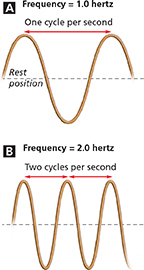17.2 Properties of Mechanical Waves
Reading Focus
Key Concepts
 What determines the frequency of a wave?
What determines the frequency of a wave? How are frequency, wavelength, and speed related?
How are frequency, wavelength, and speed related? How is the amplitude of a wave related to the wave's energy?
How is the amplitude of a wave related to the wave's energy?
Vocabulary
periodic motion
period
frequency
hertz
wavelength
amplitude
Reading Strategy
Building Vocabulary Copy and expand the table below. As you read, write a definition in your own words for each term.
Vocabulary Term |
Definition |
|---|---|
Period |
a. |
Frequency |
b. |
Wavelength |
c. |
Amplitude |
d. |
Will it be a good day for surfing? You might not think that a surfer would check the Internet to find out. But some Web sites now update ocean wave data every hour. Of course, fishing boats and naval vessels also need this information. Usually, the properties used to describe waves are period, frequency, wavelength, speed, and amplitude.
Frequency and Period
How do surfers know when the next wave is coming? If they count the time between two successive crests, the next crest usually will come after this same time interval. Any motion that repeats at regular time intervals is called periodic motion. The time required for one cycle, a complete motion that returns to its starting point, is called the period. For an ocean wave, the period is the time between two successive crests.
Any periodic motion has a frequency, which is the number of complete cycles in a given time. For a wave, the frequency is the number of wave cycles that pass a point in a given time. Frequency is measured in cycles per second, or hertz (Hz).
 A wave's frequency equals the frequency of the vibrating source producing the wave. The rope in Figure 5A is shaken with a frequency of one vibration per second, so the wave frequency is one cycle per second, or 1 hertz. In Figure 5B, the vibration is twice as fast, so the frequency is two cycles per second, or 2 hertz.
A wave's frequency equals the frequency of the vibrating source producing the wave. The rope in Figure 5A is shaken with a frequency of one vibration per second, so the wave frequency is one cycle per second, or 1 hertz. In Figure 5B, the vibration is twice as fast, so the frequency is two cycles per second, or 2 hertz.
Figure 5 Frequency is the number of complete cycles in a given time. A A wave vibrating at one cycle per second has a frequency of 1.0 Hz. B A wave vibrating at two cycles per second has a frequency of 2.0 Hz.






